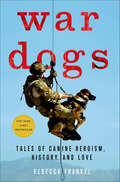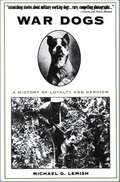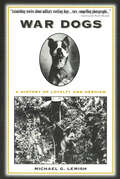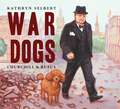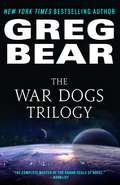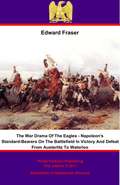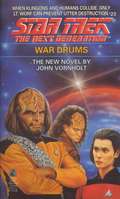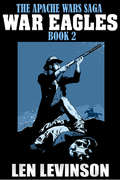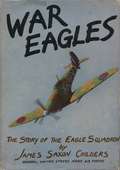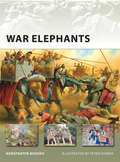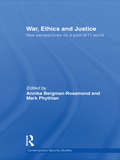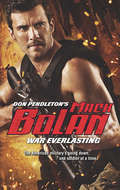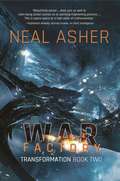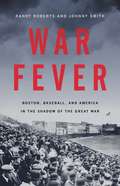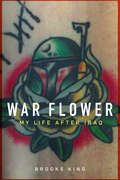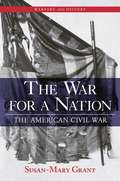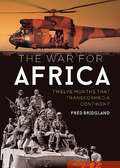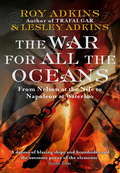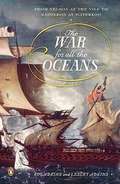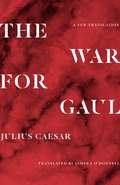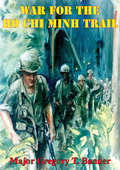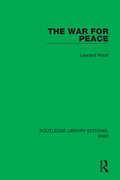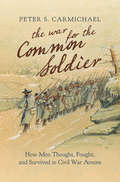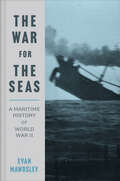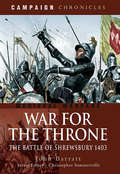- Table View
- List View
War Dogs: Tales of Canine Heroism, History, and Love
by Rebecca Frankel*A New York Times bestseller* A compelling look at the important role that dogs have played in America's most recent military conflicts, replete with the touching stories of individual dogs and their handlers/soldiersUnder the cover of night, deep in the desert of Afghanistan, a US Army handler led a Special Forces patrol with his military working dog. Without warning an insurgent popped up, his weapon raised. At the handler's command, the dog charged their attacker. There was the flash of steel, the blur of fur, and the sound of a single shot; the handler watched his dog take a bullet. During the weeks it would take the dog to heal, the handler never left its side. The dog had saved his life. Loyal and courageous, dogs are truly man's best friend on the battlefield. While the soldiers may not always feel comfortable calling the bond they form love, the emotions involved are strong and complicated. In War Dogs, Rebecca Frankel offers a riveting mix of on-the-ground reporting, her own hands-on experiences in the military working dog world, and a look at the science of dogs' special abilities--from their amazing noses and powerful jaws to their enormous sensitivity to the emotions of their human companions. The history of dogs in the US military is long and rich, from the spirit-lifting mascots of the Civil War to the dogs still leading patrols hunting for IEDs today. Frankel not only interviewed handlers who deployed with dogs in wars from Vietnam to Iraq, but top military commanders, K-9 program managers, combat-trained therapists who brought dogs into war zones as part of a preemptive measure to stave off PTSD, and veterinary technicians stationed in Bagram. She makes a passionate case for maintaining a robust war-dog force. In a post-9/11 world rife with terrorist threats, nothing is more effective than a bomb-sniffing dog and his handler. With a compelling cast of humans and animals, this moving book is a must read for all dog lovers--military and otherwise.
War Dogs: Canines in Combat
by Michael G. LemishHistory of the United States military working dog. Contains brief discussion of early uses of war dogs with emphasis on canines used in World Wars I and II, in Korea and Vietnam.
War Dogs: Canines in Combat
by Michael G. LemishNow in trade paperback, War Dogs provides an eye-opening look at unsung canine heroes from World War I to the present. Terriers, shepherds, beagles, collies, huskies, and Dobermans are only a few of the breeds that have pulled sleds, searched caves and bunkers, and even parachuted into combat. Michael Lemish has collected true stories and rare photographs that reflect the strong bonds that have formed between war dogs and their masters as they worked together in dangerous situations. Anyone who has ever loved a dog will love this salute to these four-legged heroes.
War Dogs: Churchill & Rufus
by Kathryn SelbertWinston Churchill, the prime minister of England during World War II, was one of the greatest wartime leaders of the modern era. While he is often likened to the English bulldog due to his tenacious personality and even his physical resemblance to the breed, Mr. Churchill was actually a devoted poodle owner and held quite an affinity for his miniature poodle, Rufus, who withstood the trials of World War II by his owner’s side.Readers follow Rufus and Winston’s friendship through major events in World War II—from the bombings of London and the invasion of Normandy to post-war reconstruction. Secondary text includes quotes from Churchill himself—taken from his rousing speeches to the people of England and to the world. Backmatter includes a timeline of World War II, an author’s note about Churchill’s pets, as well as a short biography, quote sources, and a list of recommended resources for further study.In her debut picture book, Kathryn Selbert has created a unique look at a significant historical figure and period in world history.
The War Dogs Trilogy (War Dogs)
by Greg BearCollected in a single volume for the first time, the epic War Dogs trilogy of interstellar war from a master of science fiction.The Gurus made their presence on Earth known thirteen years ago. Providing technology and scientific insights far beyond what mankind was capable of, they became indispensable advisors and promised even more gifts that we just couldn't pass up.But they were followed by mortal enemies -- the Antagonists -- from sun to sun, planet to planet, and now the Gurus are stretched thin -- and they need humanity's help.Our first bill has come due. Skyrines like Michael Venn have been volunteered to pay the price. They face insidious enemies who were already inside the solar system, establishing a beachhead on Mars.Venn and his comrades will be lucky to make it out alive -- let alone preserve the future of all of mankind. The War Dogs TrilogyWar Dogs (HC: 10/14; TP: 07/15)Killing Titan (HC: 10/15; TP: 07/16)Take Back the Sky (HC: 12/16; TP: 07/17)
War Drama of the Eagles: Napoleon's Standard-Bearers On The Battlefield In Victory And Defeat From Austerlitz To Waterloo
by Pickle Partners Publishing Edward FraserThis ebook is purpose built and is proof-read and re-type set from the original to provide an outstanding experience of reflowing text for an ebook reader. The eagle of Napoleon was a potent symbol of military might, men fought and died to possess the "cou-cou" that his regiments carried into battle. It represented the fidelity of a regiment to the cause of the French Empire, and more particularly the attachment of the brave warriors who fought beneath it to the greatest general of the age. To lose an eagle was to lose the honour of the regiment, a stain that could not be removed apart from rare cases of exceptional service. Edward Fraser chronicles the history of the Napoleonic eagle standard and the men who fought under them and against them until the final demise of the Napoleonic era after Waterloo in 1815. Napoleon was well aware of how to stimulate the esprit de corps of his armies with symbols and continuing his innovation of giving distinct standards to specific regiments and recording battle honours on them from his time with the army of Italy, he decided on giving each battalion or squadron and eagle based on his own imperial insignia. The eagle of the battalion was the rallying point for the men in adversity, and a stimulant on the attack guiding the men toward their objective. Napoleon's enemies knew the power and cachet of capturing such a standard and fought hard to capture them on battlefields ranging from Borodino outside Moscow to the hot plains outside Cadiz in Spain. Fraser was a prominent historian of the period having written a number of books on the great battle of Trafalgar and Wellington's soldiers in the Peninsula. This work was written just before the outbreak of the First World War, with the Entente Cordiale in place, and is therefore more balanced than some of the earlier English works on the period which tended to a more anti-French view. Text taken, whole and complete, from the 1912 edition, published in London, John Murray. Original -444 pages Illustrations - 10 - all included Maps - 7 - all included Author - Edward Fraser - (????-????) Linked TOC. -the TOC includes the summary notes of each chapter.
War Drums (Cold Equations #23)
by John VornholtThe planet Selva -- a lush colony world settled by a hardy group of humans, who found theplanet already inhabited by a small gang of young Klingons. When violence erupts between the two groupas, Captain Picard and the U.S.S. Enterprise are sent to reder assistance. Worf leads a landing party to the planet while the Starship Enterprise is called away on another urgent mission. On Selva, Worf and his party find that the old hatreds and prejudices between humans and Klingons are revived, and the settlers are out for blood. Now, Worf must prevent a horrible massacre before all of them fall prey to Selva's deadly secret...and raging fury.
War Eagles
by Frank BurlesonIn the North, a lanky lawyer named Abraham Lincoln was recovering from a brutal political setback. In the South, eloquent US Senator Jefferson Davis was risking all in a race for governor of his native Mississippi. And far to the Southwest, the future of the frontier was being decided as the US Army, under Colonel Bull Moose Sumner, faced the growing alliance of Native Americans led by the great Mangas Coloradas and determined to defend their ancestral lands.For First Lieutenant Nathanial Barrington it was his first test as a professional soldier, following orders he distrusted in an undeclared war without conscience or quarter—and his test as a man when he met the Apache woman warrior Jocita in a night lit by passion that would yield to a day of dark decisions. The tremendous second novel of the authentic Apache Wars Saga that began with Desert Hawks.
War Eagles: The Story of The Eagle Squadron
by Col. James Saxon ChildersWritten by Colonel James Saxon Childers, who served in the U.S. Army Air Force during World War II, this book, which was first published in 1943, provides an informal account of the American Eagle Squadron attached to Great Britain's Royal Air Force.Contains over 100 illustrations, including maps.
War Elephants
by Peter Dennis Konstantin NossovElephants have been deployed as weapons for centuries, particularly in South and South-East Asia, where war elephants constituted the bulk of most armies in the region from antiquity right up to the 19th century. This book offers an insight into the incredible history of these "living tanks," focusing on the design of the equipment and armament that made them so terrifying, particularly the development and structure of the fighting tower.The author, Konstantin S. Nossov goes on to trace the battle history of war elephants, from their deployment against Alexander the Great's army at the battle of Gaugamela, through to their use in the 19th century by the myriad armies of South-East Asia, all the time analyzing the battle formation and tactics of war elephants in action and how these tactics changed over time. He then goes on to examine the most famous action that war elephants took part in, Hannibal's dramatic march over the Alps and his subsequent invasion of Italy. Supported by rare illustrations and full-color original artwork, this book is a vivid account of the development and operation of one of history's most unusual "machines of warfare."
War, Ethics and Justice: New Perspectives on a Post-9/11 World (Contemporary Security Studies)
by Annika Bergman-Rosamond Mark PhythianThis edited volume addresses the key issues of ethics, war and international relations in the post-9/11 world. There is a lively debate in contemporary international relations concerning the relationship between statist obligations to one’s own political community and cosmopolitan duties to distant others. This volume contributes to this debate by investigating aspects of the ethics of national military and security and intelligence policies in the post-9/11 environment. The discursive transformation of national militaries into ‘forces for good’ became normalized as the Cold War subsided. While the number of humanitarian military interventions and operations rose considerably in the immediate post-Cold War period, the advent of the ‘war on terror’ raised questions about exactly what we mean by ethical behaviour in terms of military and security policies. This volume interrogates this key question via a focus that is both distinctive and illuminating – on national military ethics; femininities, masculinities and difference; and intelligence ethics. The key objectives are to demonstrate the important linkages between areas of international relations that are all too often treated in isolation from one another, and to investigate the growing tension between cosmopolitan and communitarian conceptions of intelligence and security and the use of armed force. This book will be of much interest to students of security studies, ethics, gender studies, intelligence studies, and international relations in general. Mark Phythian is Professor of Politics in the Department of Politics and International Relations at the University of Leicester. He is the author or editor/co-editor of ten books. Annika Bergman-Rosamond is Senior Researcher at the Danish Institute for International Studies in Copenhagen.
War Everlasting
by Don PendletonKILLER COUNTDOWN A flight carrying military service personnel goes down in the Bering Sea, and the rescue team vanishes without a trace. Called in to investigate, Mack Bolan goes undercover in an Alaskan fishing city and hones in on a criminal empire fronted by a ruthless union boss. Bolan targets their prime operations one by one, and goes up against their army of criminals. On a desolate ring of islands, Bolan discovers that an active volcano isn't the only force about to blow. A Russian mercenary and his group of fanatics are working to destroy America's network of military bases and kill unsuspecting soldiers. But the Executioner is going to turn up the heat on this frozen hell and obliterate this lethal plot with pure molten payback.
War Factory: Transformations Book Two
by Neal AsherThorvald Spear, resurrected from his death over a hundred years earlier, continues to hunt Penny Royal, the rogue AI and dangerous war criminal on the run from Polity forces. Beyond the Graveyard, a lawless and deadly area in deep space, Spear follows the trail of several enemy Prador, the crab-like alien species with a violent history of conflict with humanity. Sverl, a Prador genetically modified by Penny Royal and slowly becoming human, pursues Cvorn, a Prador harboring deep hatred for the Polity looking to use him and other hybrids to reignite the dormant war with mankind. Blite, captain of a bounty hunting ship, hands over two prisoners and valuable memplants from Penny Royal to the Brockle, a dangerous forensics entity under strict confinement on a Polity spaceship that quickly takes a keen interest in the corrupted AI and its unclear motives. Penny Royal meanwhile continues to pull all the strings in the background, keeping the Polity at bay and seizing control of an attack ship. It seeks Factory Station Room 101, a wartime manufacturing space station believed to be destroyed. What does it want with the factory? And will Spear find the rogue AI before it gets there? War Factory, the second book in the Transformation trilogy, is signature space opera from Neal Asher: breakneck pacing, high-tech science, bizarre alien creatures, and gritty, dangerous far-future worlds.
War Fever: Boston, Baseball, and America in the Shadow of the Great War
by Randy Roberts Johnny SmithA "richly detailed" portrait of the three men whose lives were forever changed by WWI-era Boston (Michael S. Neiberg): baseball star Babe Ruth, symphony conductor Karl Muck, and Harvard Law student Charles Whittlesey.In the fall of 1918, a fever gripped Boston. The streets emptied as paranoia about the deadly Spanish flu spread. Newspapermen and vigilante investigators aggressively sought to discredit anyone who looked or sounded German. And as the war raged on, the enemy seemed to be lurking everywhere: prowling in submarines off the coast of Cape Cod, arriving on passenger ships in the harbor, or disguised as the radical lecturing workers about the injustice of a sixty-hour workweek.War Fever explores this delirious moment in American history through the stories of three men: Karl Muck, the German conductor of the Boston Symphony Orchestra, accused of being an enemy spy; Charles Whittlesey, a Harvard law graduate who became an unlikely hero in Europe; and the most famous baseball player of all time, Babe Ruth, poised to revolutionize the game he loved. Together, they offer a gripping narrative of America at war and American culture in upheaval.
War Flower: My Life after Iraq
by Brooke KingBrooke King has been asked over and over what it’s like to be a woman in combat, but she knows her answer is not what the public wants to hear. The answers people seek lie in the graphic details of war—the sex, death, violence, and reality of it all as she experienced it. In her riveting memoir War Flower, King breaks her silence and reveals the truth about her experience as a soldier in Iraq. Find out what happens when the sex turns into secret affairs, the violence is turned up to eleven, and how King’s feelings for a country she knew nothing about as a nineteen-year-old become more disturbing to her as a thirty-year-old mother writing it all down before her memories fade into oblivion. The story of a girl who went to war and returned home a woman, War Flower gathers the enduring remembrances of a soldier coming to grips with post-traumatic stress disorder. As King recalls her time in Iraq, she reflects on what violence does to a woman and how the psychic wounds of combat are unwittingly passed down from mother to children. War Flower is ultimately a profound meditation on what it means to have been a woman in a war zone and an unsettling exposé on war and its lingering aftershocks. For veterans such as King, the toughest lesson of service is that in the mind, some wars never end—even after you come home.
The War for a Nation: The American Civil War (Warfare and History)
by Susan-Mary GrantThe War for a Nation provides a brief introduction to the American Civil War from the perspective of military personnel and civilians who participated in the conflict. Susan-Mary Grant brings the war, its many battles, and those who fought them – male and female, black and white – to the center of a riveting narrative that is accessible to general readers and students of American history. The War for a Nation explains, in a clear narrative structure, the war's origins, its battles, the expansion of the Union, the struggle for emancipation, and the following saga of Reconstruction. By drawing its examples from primary source documents, first-hand accounts, and scholarly research, The War for a Nation introduces readers to the human-interest aspects as well as the historiographical debates surrounding what was the most destructive war ever fought on American soil.
The War For Africa: Twelve Months That Transformed A Continent
by Fred BridglandThe story of the Cuban-South African war in Angola in 1987–88 through the eyes of the South Africans who fought in it. <p><p> The Angolan Civil War lasted over a quarter of a century, from 1975 to 2002. Beginning as a power struggle between two former liberation movements, the MPLA and UNITA, it became a Cold War struggle with involvement from the Soviet Union, Cuba, South Africa and the USA. <p> This book examines the height of the Cuban-South African fighting in Angola in 1987–88, when 3,000 South African soldiers and about 8,000 UNITA guerrilla fighters fought in alliance against the Cubans and the armed forces of the Marxist MPLA government, a force of over 50,000 men. Bridgland pieced together the course of the war, fought in one of the world’s most remote and wild terrains, by interviewing the South Africans who fought it, and many of their accounts are woven into the narrative. <p> This classic account of a Cold War struggle and its momentous consequences for the participants and across the continent, is released in a new edition with a new preface and epilogue.
The War For All The Oceans: From Nelson at the Nile to Napoleon at Waterloo
by Lesley Adkins Roy AdkinsAs France emerged from revolution, a young general named Napoleon Bonaparte invaded Egypt, hoping next to march overland to India. It would not happen. Britain swung her forces into action to battle for control of the world's sea-lanes and thus all international trade. The Battle of the Nile and then at Acre were the first sallies in what would be fifteen years of bitter fighting. It was a war won at sea, and by the time of Waterloo Britain had gained control and possessed the foundations of her vast empire.Brought vividly to life through the words and stories of the ordinary people caught up in the conflict, this is a sweeping history of the years of naval warfare that set the balance of power in Europe for the following century. Taking in gallant duels, bloody battles between huge fleets, amphibious assaults, daring coastal raids, and the subtleties of espionage and naval intelligence, this global conflict truly was THE WAR FOR ALL THE OCEANS.
The War for All the Oceans
by Roy Adkins Lesley AdkinsAs he did with his much lauded Nelson?s Trafalgar, Roy Adkins (now writing with wife Lesley) again thrusts readers into the perils and thrills of early-nineteenth-century warfare. From its very first page, this is an adventure story?a superb account of the naval war that lasted from Napoleon?s seizure of power in 1798 to the War of 1812 with the United States. Providing a ringside seat to the decisive battles, as well as detailed and vivid portraits of sailors and commanders, press-gangs, prostitutes, and spies, The War for All the Oceans is ?a rollicking, patriotic account of the Napoleonic wars that will go down well with Master and Commander fans? (The Telegraph).
The War for Gaul: A New Translation
by Julius CaesarA new translation that captures the gripping power of one of the greatest war stories ever told—Julius Caesar’s pitiless account of his brutal campaign to conquer GaulImagine a book about an unnecessary war written by the ruthless general of an occupying army—a vivid and dramatic propaganda piece that forces the reader to identify with the conquerors and that is designed, like the war itself, to fuel the limitless political ambitions of the author. Could such a campaign autobiography ever be a great work of literature—perhaps even one of the greatest? It would be easy to think not, but such a book exists—and it helped transform Julius Caesar from a politician on the make into the Caesar of legend. <P><P>This remarkable new translation of Caesar’s famous but underappreciated War for Gaul captures, like never before in English, the gripping and powerfully concise style of the future emperor’s dispatches from the front lines in what are today France, Belgium, Germany, and Switzerland. <P><P>While letting Caesar tell his battle stories in his own way, distinguished classicist James O’Donnell also fills in the rest of the story in a substantial introduction and notes that together explain why Gaul is the “best bad man’s book ever written”—a great book in which a genuinely bad person offers a bald-faced, amoral description of just how bad he has been. <P><P>Complete with a chronology, a map of Gaul, suggestions for further reading, and an index, this feature-rich edition captures the forceful austerity of a troubling yet magnificent classic—a book that, as O’Donnell says, “gets war exactly right and morals exactly wrong.”
War For The Ho Chi Minh Trail
by Major Gregory T. BannerThis paper studies the lines of communications (the Ho Chi Minh Trail) which went from North to South Vietnam, through Laos, during the Second Indochina War. The purpose of this paper is to study the proposal that the United States, during the Vietnam War, should have used ground forces in Laos to block these routes.In providing background information, this study examines the nature of the Ho Chi Minh Trail, political and strategic considerations, and US military actions which were applied against the trail network.Studying the military feasibility of an interdiction effort on the ground, this study finds that the US was physically capable of mounting an operation into Laos to block the Ho Chi Minh Trail.The finding of this study is, however, that such a move would not by itself have provided a winning solution to the war. Additionally, such an attack into Laos would have had serious adverse consequences for that country and US desires for the region.The conclusion of this study is that in this case (the Second Indochina War) a ground interdiction of enemy LOCs would not have been a productive course of action.
The War for Peace (Routledge Library Editions: WW2 #40)
by Leonard WoolfIn this book, first published in 1940, Leonard Woolf lays out the necessity for the establishment of a system providing for the rule of international law and cooperation, control of international power and collective defence against international aggression. He lays bare the issues at stake in the Second World War and draws lines on which a lasting peace could be framed.
The War for the Common Soldier: How Men Thought, Fought, and Survived in Civil War Armies (Littlefield History of the Civil War Era)
by Peter S. CarmichaelHow did Civil War soldiers endure the brutal and unpredictable existence of army life during the conflict? This question is at the heart of Peter S. Carmichael's sweeping new study of men at war. Based on close examination of the letters and records left behind by individual soldiers from both the North and the South, Carmichael explores the totality of the Civil War experience--the marching, the fighting, the boredom, the idealism, the exhaustion, the punishments, and the frustrations of being away from families who often faced their own dire circumstances. Carmichael focuses not on what soldiers thought but rather how they thought. In doing so, he reveals how, to the shock of most men, well-established notions of duty or disobedience, morality or immorality, loyalty or disloyalty, and bravery or cowardice were blurred by war. Digging deeply into his soldiers' writing, Carmichael resists the idea that there was "a common soldier" but looks into their own words to find common threads in soldiers' experiences and ways of understanding what was happening around them. In the end, he argues that a pragmatic philosophy of soldiering emerged, guiding members of the rank and file as they struggled to live with the contradictory elements of their violent and volatile world. Soldiering in the Civil War, as Carmichael argues, was never a state of being but a process of becoming.
The War for the Seas: A Maritime History of World War II
by Evan MawdsleyThis &“impeccable, myth-busting study&” of WWII maritime operations sheds new light on the conflict with sharp analysis and an international perspective (The Sunday Times, UK). Command of the oceans was crucial to winning World War II. By the start of 1942 Nazi Germany had conquered mainland Europe, and Imperial Japan had overrun Southeast Asia and much of the Pacific. How could Britain and distant America prevail in what had become a "war of continents"? In this definitive account, Evan Mawdsley traces events at sea from the first U-boat operations in 1939 to the surrender of Japan. He argues that the Allied counterattack involved not just decisive sea battles, but a long struggle to control shipping arteries and move armies across the sea. Covering all the major actions in the Atlantic and Pacific oceans, as well as those in the narrow seas, this book interweaves for the first time the endeavors of the maritime forces of the British Empire, the United States, Germany, and Japan, as well as those of France, Italy, and Russia.
War for the Throne: The Battle of Shrewsbury, 1403 (Campaign Chronicles Ser.)
by John BarrattThe opening years of the fifteenth century saw one of the most bitterly contested political and military convulsions in the history of the British Isles, a conflict that is too-often overlooked by military historians. Henry IV, who had overthrown and probably murdered his predecessor Richard II, fought a protracted and bloody campaign against the most powerful nobles in the land. This war is the subject of John Barratts gripping study.The Percy family, the Kings of the North, and their most famous leader Sir Henry Percy Hotspur, whose fiery nature and military prowess were immortalized by Shakespeare stood out against Henrys rule. And the beleaguered king also had to contend with a range of other unrelenting opponents, among them Owain Glyn Dwr, who led the Welsh revolt against English supremacy. In this graphic account of the first, deeply troubled years of Henry IVs reign, John Barratt concentrates on the warfare, in particular on the set piece pitched battles fought at Homildon Hill, Pilleth and Shrewsbury. His story brings to life the embittered politics and the personal and family enmities that gave rise to armed conflict. And he describes in vivid detail the tactics and fighting methods of the day, which were dominated by the devastating power of the English longbow.
